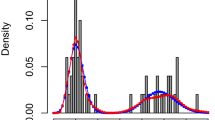Abstract
Kernel density estimators are often used to estimate the utilization distributions (UDs) of animals. Kernel UD estimates have a strong theoretical basis and perform well, but are usually reported without estimates of error or uncertainty. It is intuitively and theoretically appealing to estimate the sampling error in kernel UD estimates using bootstrapping. However, standard equations for kernel density estimates are complicated and computationally expensive. Bootstrapping requires computing hundreds or thousands of probability densities and is impractical when the number of observations, or the area of interest is large. We used the fast Fourier transform (FFT) and discrete convolution theorem to create a bootstrapping algorithm fast enough to run on commonly available desktop or laptop computers. Application of the FFT method to a large (n>20,000) set of radio telemetry data would provide a 99.6% reduction in computation time (i.e., 1.6 as opposed to 444 hours) for 1000 bootstrap UD estimates. Bootstrap error contours were computed using data from a radio-collared polar bear (Ursus maritimus) in the Beaufort Sea north of Alaska.
Similar content being viewed by others
References
Bethke, R., Taylor, M.K., Amstrup, S.C., and Messier, F. (1996) Population delineation of polar bears using satellite collar data. Ecological Applications, 6, 311–17.
Burt, W.H. (1943) Territoriality and home range concepts as applied to mammals. Journal of Mammalogy, 24, 346–52.
Calhoun, J.B. and Casby, J.U. (1958) Calculation of home range and density of small mammals, Public Health Monograph Number 55. United States Department of Health, Education and Welfare, Washington, D.C., USA.
Cooley, J.W. and Tukey, J.W. (1965) An algorithm for the machine calculation of complex Fourier series. Mathematics of Computation, 19, 297–301.
Dixon, K.R. and Chapman, J.A. (1980) Harmonic mean measure of animal activity areas. Ecology, 6, 1040–4.
Efron, B. (1982) The Jackknife, the Bootstrap, and Other Resampling Methods, CBMS-NSF Monograph 38. Society for Industrial and Applied Mathematics, Philadelphia, Pennsylvania, p. 92.
Härdle, W.K. and Scott, D.W. (1992) Smoothing by weighted averaging of rounded points. Computational Statistics, 7, 97–128.
Hurlbert, S.H. (1984) Pseudoreplication and the design of ecological field experiments. Ecological Monographs, 54, 187–211.
Manly, B.F.J. (1991) Randomization and Monte Carlo Methods in Biology. Chapman and Hall, New York.
Monro, D.M. (1976) Algorithm AS 97. Real discrete fast Fourier transform. Applied Statistics, 25, 166–72.
Press, W.H., Flannery, B.P., Teukolsky, S.A., and Vetterling, W.T. (1988) Numerical Recipes: The Art of Scientific Computing, Cambridge University Press, Cambridge.
Raphael, M.G. and Brink, G.E. (1988) Bootstrap estimation of home range area: user's guide to program HOMERANG, General technical report RM165. U.S. Forest Service, Rocky Mountain Forest and Range Experiment Station, Fort Collins, Colo.
Scott, D.W. and Sheather, S.J. (1985) Kernel density estimation with binned data. Communications in Statistics, Theory and Methods, 14, 1353–9.
Seaman, D.E. and Powell, R.A. (1996) An evaluation of the accuracy of kernel density estimators for home range analysis. Ecology, 77, 2075–85.
Silverman, B.W. (1982) Kernel density estimation using the fast Fourier transform. Applied Statistics, 31, 93–9.
Silverman, B.W. (1986) Density estimation for statistical and data analysis, Chapman and Hall, New York.
Simonoff, J.S. (1996) Smoothing methods in statistics, Springer, New York.
Venables, W.N. and Ripley, B.D. (1999) Modern applied statistics with S-PLUS, third edition, Springer, New York.
Wand, M.P. and Jones, M.C. (1995) Kernel Smoothing, Chapman and Hall, London.
White, G.C. and Garrott, R.A. (1990) Analysis of wildlife radio-tracking data, Academic Press, New York.
Worton, B.J. (1989) Kernel methods for estimating the utilization distribution in home-range studies. Ecology, 70, 164–8.
Yfantis, A. and Borgman, L.E. (1981) Fast Fourier Transforms 2–3–5. Computers and Geosciences, 7, 98–108.
Author information
Authors and Affiliations
Rights and permissions
About this article
Cite this article
Kern, J.W., McDonald, T.L., Amstrup, S.C. et al. Using the bootstrap and fast Fourier transform to estimate confidence intervals of 2D kernel densities. Environmental and Ecological Statistics 10, 405–418 (2003). https://doi.org/10.1023/A:1026092103819
Issue Date:
DOI: https://doi.org/10.1023/A:1026092103819




